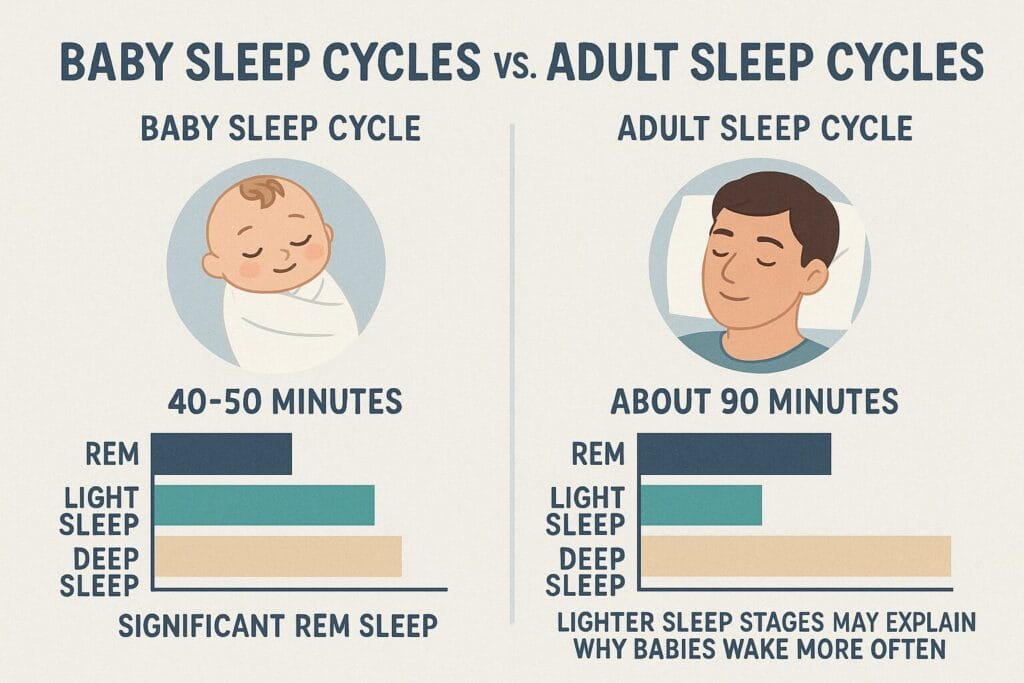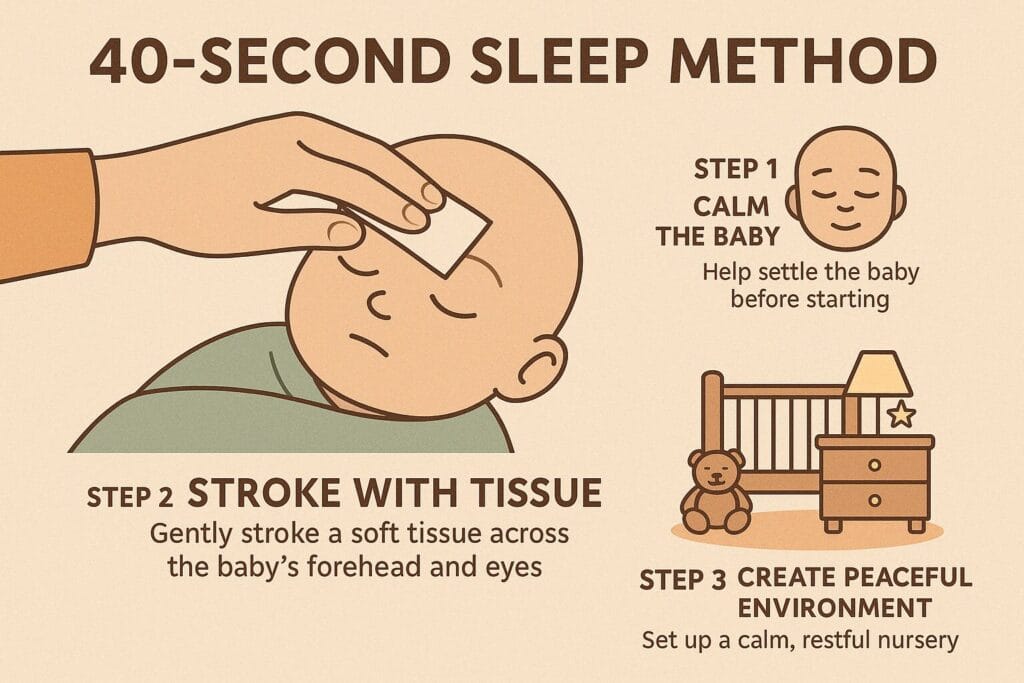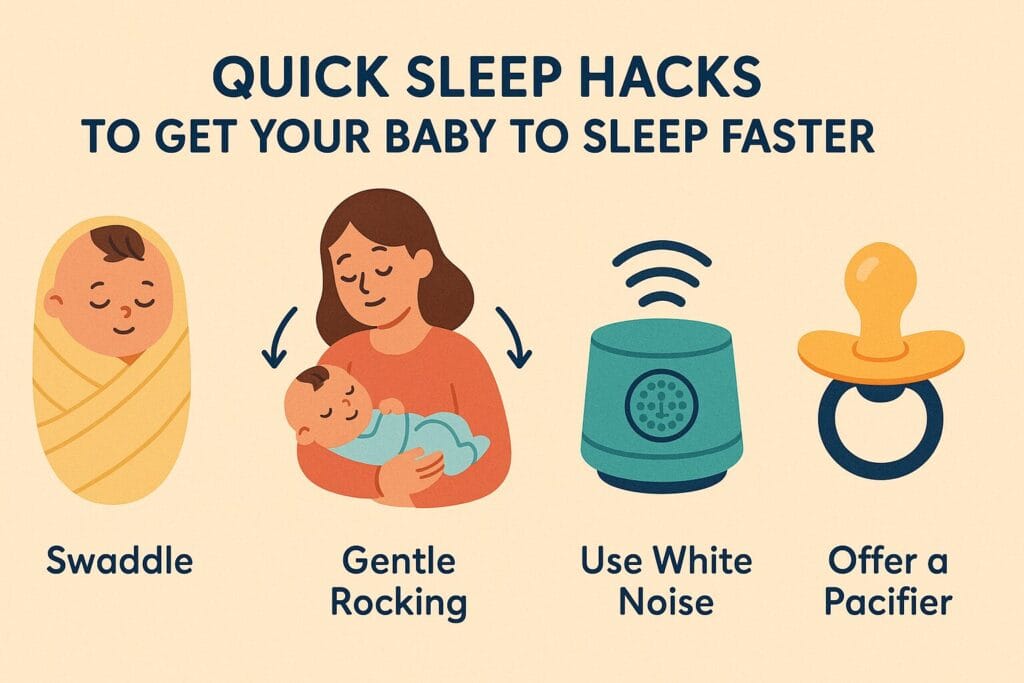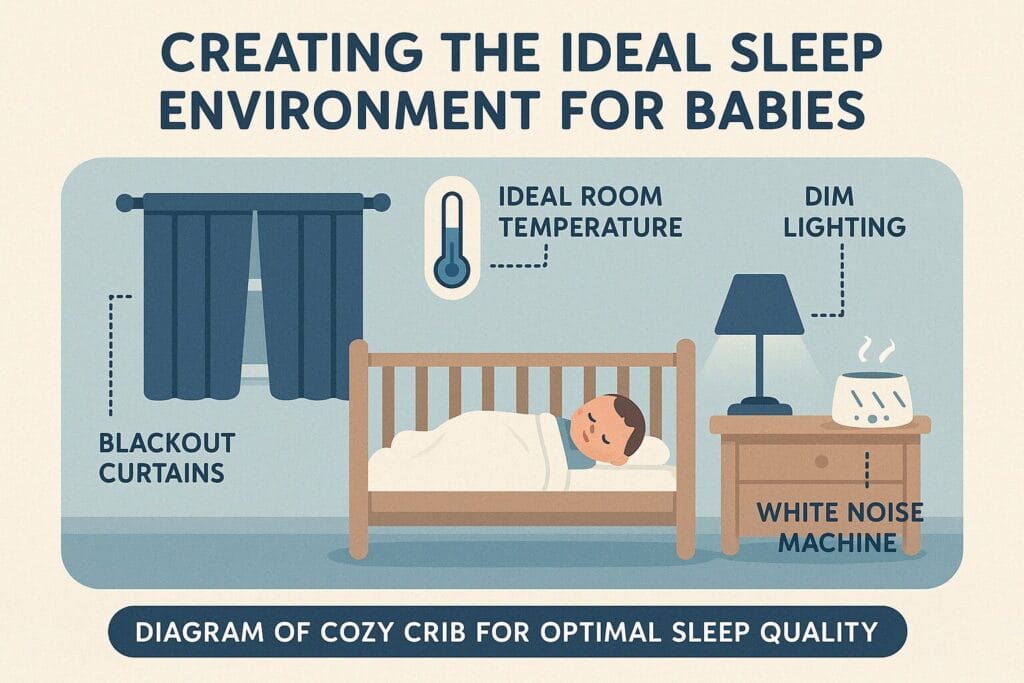If you’re a new parent, you know that getting your baby to sleep can be one of the toughest challenges. Endless hours of rocking, soothing, and trying every method possible can be draining. But what if we told you that there’s a trick for how to put a baby to sleep in 40 seconds? It might sound unbelievable, but this method, along with other techniques, can help soothe your baby quickly and effectively. In this guide, we’ll break down how to put a baby to sleep in 40 seconds and give you other quick sleep hacks that will make bedtime easier for you and your baby.
Table of Contents
Why Baby Sleep is Different From Ours

One of the main reasons parents struggle with sleep is that babies’ sleep cycles are vastly different from adult sleep cycles. Babies have shorter sleep cycles, typically lasting around 40-50 minutes, and they spend a significant amount of time in REM sleep, which is a lighter stage of sleep. This is why babies often wake up more frequently, needing assistance to fall back asleep.
This is also the reason why knowing how to put a baby to sleep in 40 seconds can be such a game-changer. Since babies are in light sleep, they can be easily woken up, and having a quick method to soothe them back to sleep can make a big difference.
Understanding your baby’s sleep patterns is the first step in making bedtime easier. Knowing how to put a baby to sleep in 40 seconds can help you settle your baby faster, reducing the stress for both of you during those long nights.
What Causes Babies to Struggle With Sleep?

There are many reasons your baby might be struggling to fall asleep, and understanding these factors is crucial when trying to figure out how to put a baby to sleep in 40 seconds. Here are some common sleep disruptors:
1. Overstimulated or Overtired Babies
Babies, especially in their early months, need to be put down for sleep at the right time. Overstimulated or overtired babies are harder to soothe and often become cranky and difficult to settle down.
What You Can Do:
To avoid an overtired baby, be mindful of their wake windows. Babies generally have a limited amount of time they can stay awake before they become overtired and start fighting sleep. If your baby is already overstimulated, you can try how to put a baby to sleep in 40 seconds by soothing them quickly with a calming technique.
Struggling with an overtired newborn who just won’t sleep? Discover 7 proven strategies to help your baby fall asleep fast and peacefully. Click here to unlock the secrets to better sleep!
2. Hunger or Feeding Needs
One of the most common reasons babies wake up is hunger. Babies, especially newborns, need frequent feedings. If your baby is waking up constantly during the night, it could be due to hunger.
What You Can Do:
Offer a dream feed before you go to bed. This is a feeding where you feed your baby while they are still drowsy or asleep, helping them sleep longer through the night. Ensuring your baby’s hunger is taken care of before bed can help you get them into a deep sleep faster and possibly make it easier to put them to sleep in 40 seconds.
3. Day and Night Confusion
Newborns don’t yet have a fully developed circadian rhythm. As a result, they often sleep more during the day and stay awake at night. This day-night confusion can make it more challenging for parents trying to figure out how to put a baby to sleep in 40 seconds.
What You Can Do:
Expose your baby to natural sunlight during the day to help them adjust to the natural cycle of day and night. Keep the room dark at night with blackout curtains to signal that it’s time for sleep.
How to Put a Baby to Sleep in 40 Seconds: The 40-Second Trick

The idea of how to put a baby to sleep in 40 seconds is not as impossible as it may sound. This method has gained traction among parents who have found success using a simple, soothing technique to calm their babies quickly.
What Is the 40-Second Trick?
The 40-second trick involves using a soft, dry tissue to stroke your baby’s forehead and eyes. This repetitive motion mimics the calming effect of being rocked or nursed and helps relax your baby, making it easier for them to fall asleep.
How to Do It:
- Set the Right Environment:
Create a peaceful environment by dimming the lights, reducing noise, and ensuring that your baby is fed and comfortable. White noise is also a great option for helping your baby fall asleep faster. - Prepare a Soft Tissue:
Take a soft, clean tissue and gently hold it in your hand. It should be dry and soft to the touch to prevent irritation on your baby’s delicate skin. - Gentle Strokes on the Forehead:
Start at your baby’s forehead and gently stroke the tissue down toward their eyes. The motion should be slow and rhythmic. Repeat this motion a few times, and you’ll notice your baby begin to relax. - Wait for Sleep:
After about 40 seconds, many babies will have calmed down and fallen asleep. If your baby doesn’t fall asleep right away, continue the gentle strokes until they doze off.
The 40-second sleep trick is effective because it helps mimic soothing motions, allowing your baby to drift off quickly. This method works well when you need a fast solution for how to put a baby to sleep in 40 seconds.
Other Effective Hacks for Getting Your Baby to Sleep Quickly

If the 40-second sleep trick doesn’t work for your baby, there are many other tried-and-tested methods that can help you get your baby to sleep faster. If you’re still figuring out how to put a baby to sleep in 40 seconds, these alternatives can be just as effective.
1. White Noise for Soothing
White noise creates a consistent sound environment that can be comforting for babies. It mimics the constant sounds they heard in the womb, making it easier for them to relax and fall asleep quickly. A white noise machine is an excellent tool for helping your baby fall asleep faster.
2. Swaddling
Swaddling is a traditional and effective way to help babies feel secure. It prevents the Moro reflex (startle reflex), which often wakes babies up during sleep. By wrapping your baby snugly in a soft swaddle, you can help them feel cozy and calm, making it easier to get them to sleep faster.
If your baby won’t sleep without a swaddle but has started rolling over, it’s time for a safe transition. Discover 7 smart solutions and safety tips every parent should know. Click here to help your baby sleep soundly and securely!
3. Rocking or Motion
Many babies respond well to gentle rocking. Whether you rock them in your arms or use a baby swing, the gentle motion can help them relax. If you’re trying to figure out how to put a baby to sleep in 40 seconds, rocking might be a great option to combine with other techniques like swaddling or white noise.
4. Pacifiers for Comfort
For many babies, sucking on a pacifier is a natural way to soothe themselves. The act of sucking releases calming hormones that help babies feel relaxed and ready for sleep. If your baby is still learning how to put a baby to sleep in 40 seconds, a pacifier can assist in the process by calming them down quickly.
Creating a Consistent Bedtime Routine
Consistency is key when teaching your baby how to put a baby to sleep in 40 seconds. Establishing a bedtime routine signals to your baby that it’s time to wind down and sleep. A predictable routine will help your baby associate certain activities with sleep, making it easier for them to fall asleep quickly.
Steps to Build a Bedtime Routine:
- Warm Bath:
A warm bath can relax your baby and help them unwind after a long day. The soothing water can signal that it’s time to go to sleep. - Feeding:
Offer your baby a feeding before bed to ensure they aren’t hungry during the night. This can help prevent mid-night wakeups. - Lullabies and Cuddling:
Singing a lullaby or gently rocking your baby can help them transition to sleep. The comfort of your voice or the rhythmic motion can help them feel safe and secure. - Put Baby Down Drowsy But Awake:
Lay your baby down in their crib when they’re drowsy but still awake. This teaches them how to fall asleep independently, which is an important skill in the long run.
Creating the Ideal Sleep Environment

The sleep environment plays a significant role in how easily your baby will fall asleep. When trying to figure out how to put a baby to sleep in 40 seconds, it’s crucial to ensure the environment is as calming as possible.
1. Darkness is Key
Babies sleep better in a dark environment. Consider using blackout curtains to ensure the room stays dark, even during naps or in the morning.
2. Room Temperature
Ensure the room temperature is comfortable, ideally between 68-72°F (20-22°C). Babies are more sensitive to temperature changes, and a comfortable environment will help them sleep longer.
Not sure if your baby’s room is too hot or too cold? Check out the Baby Sleep Temperature Chart – your ultimate guide to ensuring safe and comfortable sleep. Click here to learn how to create the perfect sleep environment!
3. White Noise for Comfort
If your baby is sensitive to sound, white noise can help mask other noises in the environment. A white noise machine is an excellent investment for creating a soothing atmosphere.
Top Baby Sleep Products
When you’re learning how to put a baby to sleep in 40 seconds, it helps to have the right tools at your disposal. Here are some of the top products that can make a huge difference in your baby’s sleep quality:
1. Halo SleepSack
The Halo SleepSack is a wearable blanket that provides a secure and safe alternative to loose blankets. It’s perfect for keeping your baby cozy and safe as they fall asleep.
2. Hatch Sound Machine
The Hatch Sound Machine is one of the top-rated white noise machines. It helps create a soothing sleep environment and can be customized to suit your baby’s needs.
3. Love to Dream Swaddle UP
The Love to Dream Swaddle UP is a great option for babies who prefer to sleep with their arms up. This swaddle allows babies to self-soothe while still feeling secure.
4. Snoo Smart Sleeper
The Snoo Smart Sleeper is a high-tech bassinet that automatically rocks your baby and plays soothing sounds to help them fall asleep. It’s an excellent tool for parents looking for extra help.
When to Seek Professional Help
If your baby continues to struggle with sleep despite trying various methods, it might be time to consult a sleep consultant. A professional can help you create a personalized sleep plan for your baby.
FAQS (How to Put a Baby to Sleep in 40 Seconds)
1. What is the 40-second sleep method for babies?
The 40-second sleep method is a quick, calming technique where parents use a soft tissue to gently stroke their baby’s forehead and eyes. This method mimics soothing motions like rocking or nursing, which can help babies fall asleep quickly, often in around 40 seconds. Many parents have used this technique to learn how to put a baby to sleep in 40 seconds, and it has become a popular sleep hack for those looking for a quick solution.
2. Does the 40-second sleep trick work for all babies?
While the 40-second sleep method is effective for many babies, it doesn’t work for every baby. Some babies may respond better to other techniques, such as rocking, swaddling, or using a pacifier. If you’re trying to figure out how to put a baby to sleep in 40 seconds, it’s worth experimenting with this trick along with other soothing techniques to find what works best for your baby.
3. Why do babies need help falling asleep?
Babies have shorter sleep cycles, usually around 40-50 minutes, and spend more time in REM sleep, which is lighter. This makes it easier for them to wake up and need assistance getting back to sleep. How to put a baby to sleep in 40 seconds is a useful trick because it helps babies quickly return to sleep during these light sleep phases. Understanding the nature of baby sleep is key to knowing how to put a baby to sleep in 40 seconds effectively.
4. Is it safe to use the 40-second sleep trick on my baby?
Yes, the 40-second sleep method is completely safe for most babies when done correctly. Use a soft, dry tissue to gently stroke your baby’s forehead and eyes. It’s important to monitor your baby during the process and ensure that they are comfortable. The 40-second sleep trick should be a soothing, relaxing experience, not one that causes stress or discomfort for your baby.
5. How can I tell if my baby is ready to sleep?
Knowing how to put a baby to sleep in 40 seconds starts with recognizing when your baby is ready to sleep. Signs include yawning, eye rubbing, becoming fussy, or looking away from stimulation. Once your baby shows these signs, it’s time to use methods like the 40-second sleep trick to help them fall asleep quickly and peacefully.
6. What if my baby won’t fall asleep after trying the 40-second method?
If your baby doesn’t fall asleep after trying the 40-second sleep method, don’t be discouraged. Not all babies will respond to this method immediately. If you’re trying how to put a baby to sleep in 40 seconds, continue gently applying the technique, or try combining it with other calming methods like swaddling or white noise. Some babies may need more time or different techniques to relax and fall asleep.
7. Can I use the 40-second sleep trick after nighttime feedings?
Yes! The 40-second sleep trick can be used after your baby’s nighttime feedings. After you feed your baby, they may be drowsy but still need a little help falling back asleep. Use how to put a baby to sleep in 40 seconds after the feeding to help your baby transition back to sleep without too much disruption.
8. Should I use the 40-second sleep method as part of a bedtime routine?
Absolutely! Integrating how to put a baby to sleep in 40 seconds into your baby’s bedtime routine can be very effective. Consistent, calming routines help babies learn when it’s time to sleep. You can try using the 40-second sleep method as the final step in a series of activities like bathing, feeding, and singing lullabies. This will help signal to your baby that it’s time for sleep.
9. What are some other quick sleep hacks for getting my baby to sleep faster?
If you’re trying to figure out how to put a baby to sleep in 40 seconds, you can try combining this method with other fast and effective techniques. White noise machines, swaddling, gentle rocking, or offering a pacifier can all help calm your baby. Each baby is different, so experimenting with different methods may help you discover the best way to put a baby to sleep in 40 seconds.
10. When should I start sleep training my baby?
Sleep training usually begins when your baby is between 4 to 6 months old, as that’s when they start to develop the ability to sleep for longer stretches. However, methods like how to put a baby to sleep in 40 seconds can be used even before sleep training begins. Once your baby is older and ready for formal sleep training, you can incorporate more structured methods to help your baby learn to fall asleep independently.
Conclusion: You Can Help Your Baby Sleep Quickly and Peacefully
Getting your baby to sleep quickly and peacefully can be one of the most rewarding achievements as a parent. By understanding how to put a baby to sleep in 40 seconds, along with other soothing techniques, you can create a calming bedtime routine that helps your baby fall asleep faster. The 40-second sleep method offers a simple and effective solution for many parents, but it’s important to remember that each baby is unique. While this trick may work wonders for some, others might require a combination of methods like swaddling, rocking, or white noise.
The key is to be patient, consistent, and observant of your baby’s needs. From recognizing when they are tired to creating the perfect sleep environment, there are many ways you can guide your baby into restful sleep. Whether you’re using the 40-second sleep method, experimenting with other hacks, or sticking to a tried-and-tested bedtime routine, finding what works for your baby will make bedtime less stressful and more enjoyable for both of you.
Above all, remember that how to put a baby to sleep in 40 seconds isn’t about perfection; it’s about understanding your baby’s needs and finding comfort in knowing that you’re helping them rest, grow, and thrive. Stay patient, and enjoy those quiet moments of peace once your baby drifts off to sleep.



